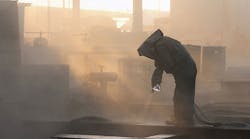When Dr. David Michaels assumed the role of Assistant Secretary of Labor for Occupational Safety and Health back in December 2009, the proposed silica standard was sitting on a chair “literally collecting dust,” Michaels said.
Appointed by recently elected President Barack Obama, Michaels and the Department of Labor at that time made a commitment to passing a new rule on silica exposure during the Obama administration’s tenure.
“We did it,” Michaels said Thursday, during an event at the International Masonry Institute in Bowie, Md. “Today, as millions of workers across the country are able to breathe a little easier, I also breathe a sigh of relief.”
That’s because a new standard for silica exposure had been in the works for decades, delayed for years by politics and naysayers, proponents say. But finally, after proposed rules and hearings and revisions, the rule stands.
It establishes two standards – one for general industry and maritime and one for the construction industry – and limits exposure to an 8-hour time-weighted average of 50 micrograms of respirable crystalline silica per cubic meter of air. Employers will have to be compliant within one year (construction), two years (general industry and maritime) and five years (hydraulic fracturing).
And even now, as the rule is issued, U.S. Labor Secretary Thomas Perez expects there to be what FDR called “calamity howlers” – people who will claim “the sky is falling, compliance is impossible and this rule will put them out of business.”
“Compliance for so many companies comes down to this: Wipe it down or vacuum it up. The it is dust. This is not rocket science,” Perez said.
For too long, the department has heard detractors calling for more studies to be done on the effects of silica exposure; it was time to act, Perez said.
“The 1970 standards were quite literally out of date the minute they went into effect. Working people have been paying the price on construction sites and workplaces ever since,” Perez said. “Like asbestos, tobacco and seatbelts, the science is clear. It’s taken over 40 years for the politics to catch up with the science.”
